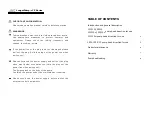
Exercise A
27
maintain constant water level in the upstream pool (in this case there will be a
small continuous overflow from the upper pool). Smooth out any sharp
irregularities of the sand bed which may have formed while filling the pool.
Fix the bottle with dye on the stand in such a position that the liquid level is
approximately at the same elevation as the water level in the upper pool.
Then, depending on the desired number of flow lines (3 to 4 recommended),
insert the corresponding number of dye-injection needles vertically about
6mm into the sand along one of the transparent walls of the upper pool. In
order to obtain an approximately "square" flow net, the spacing between the
needles should progressively increase in the upstream direction from the
impermeable screen. The suggested needle distances from the screen for 4
flow lines, are approximately 50, 115, 230, 380mm. Tape the needles (or the
tubes connecting them with the bottle) to the tank wall just above the water.
After the dye-injection needles have been fixed, lift the bottle with dye and
position it so that the liquid level is about 12mm above the water level in the
upper pool. The position of the bottle should be adjusted according to the
appearance of the flow lines. If lines are wide, the bottle is too high. If no dye
appears or its flow is irregular, the bottle is too low. The formation of flow lines
may require several minutes to an hour or two, depending on the permeability
of the sand used.
To stop the experiment, shut off the dye input by lowering dye container until
dye surface is about 50mm below water level in pool. Let the flow lines wash
away. Do not take out the needles before the dye input has been shut off as
indicated. Otherwise dye will get into water in the pool while needles are
being removed.
ii.
Flow Net Construction
Trace the flow line pattern and the boundary conditions (the perimeter of the
cross section of the body of sand in the tank) on tracing paper taped to the
transparent wall of the tank. Use a felt marker to prevent erasing the contours
which are to serve as a firm skeleton of the net when sketching in the
completed net with a pencil later on.
To obtain a square flow net, try first to fit the squares between one pair of the
experimentally obtained flow lines. Proceed with the sketching of the
equipotential lines from the upstream to the downstream boundary (ie.
upstream sand surface to downstream sand surface) using care to obtain
right angle intersections.
On the first trial, a narrow residual rectangle will probably occur at the end.
The correction can be made in two ways. The width of the "channel" formed
by the two experimental flow lines can be either increased or reduced by
drawing a parallel trial line close to one of the original lines.
Using this corrected flow line instead of one of the experimental ones, a new
set of squares is fitted into the "channel". If the new "channel" is wider than
the original, the length of the residual rectangle will reduce eventually to zero.
If it is narrower, the residual rectangle will eventually be lengthened until it
approximates a square.
Once the square net between one pair of flow lines has been established, the
equipotential lines can be extended across the whole flow field so that they
















































